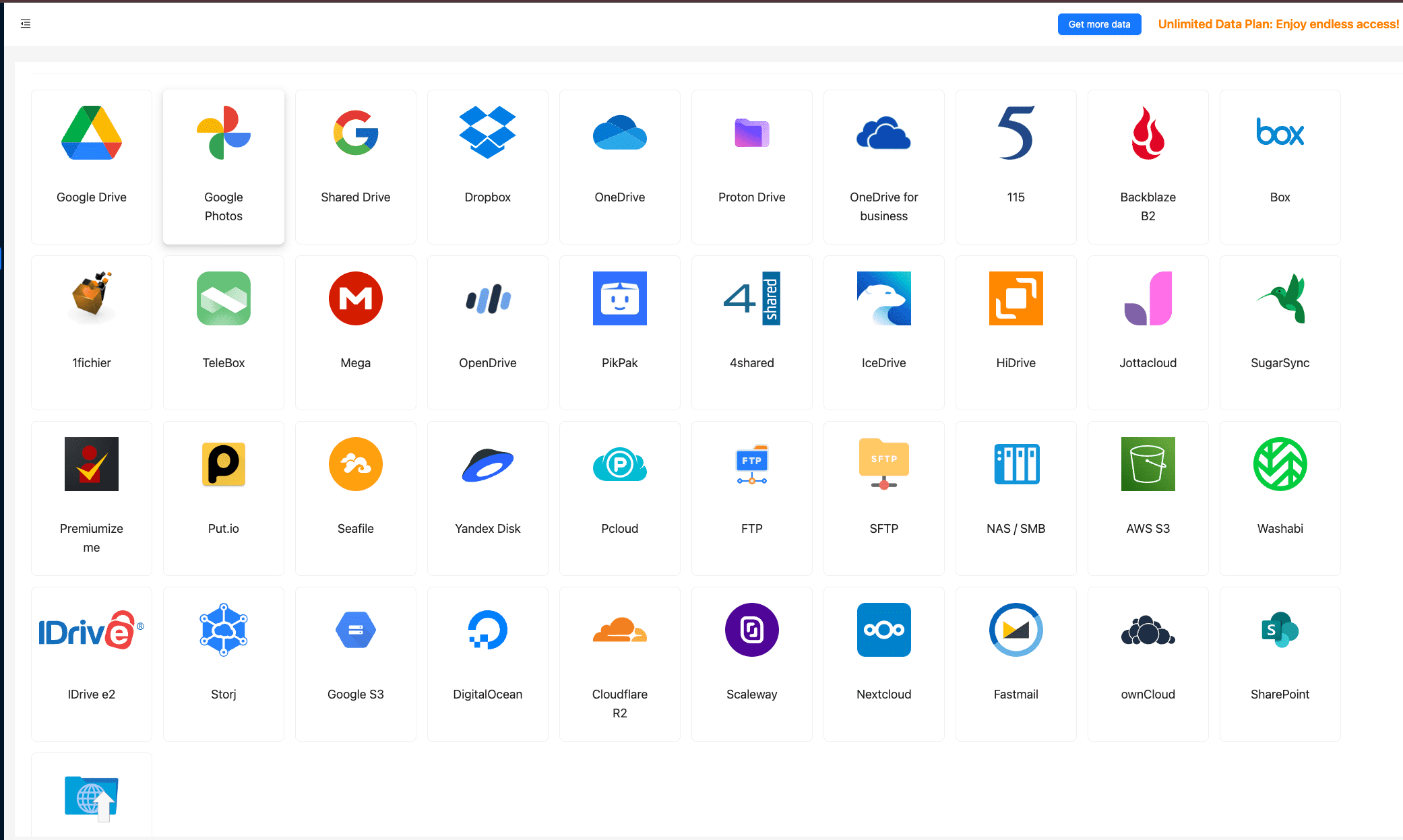How to Migrate Files from Other Cloud Services to FileLu in 2025
Learn how to transfer your files from multiple cloud services to FileLu seamlessly, ensuring a smooth transfer process with minimum downtime.
Introduction
In the fast-evolving world of cloud storage, transitioning files to a new service like FileLu can offer more advanced features, cost benefits, and superior integration capabilities. This guide provides a comprehensive overview of how to shift your files from various cloud platforms to FileLu efficiently, safeguarding data integrity and reducing transition times.
FileLu is a modern and secure cloud storage service designed for both individuals and teams who value privacy, performance, and scalability. It provides a straightforward platform for uploading, organizing, and sharing digital files with capacities ranging from free starter plans to enterprise-grade tiers that support multi-terabyte storage.
The platform allows uploads through web browsers, mobile apps, or via protocols like FTP and WebDAV, making it flexible for users who manage data across devices. FileLu also supports direct link sharing, automatic backup, and end-to-end encryption for sensitive content.
- Cross-Platform Access: Access your files from any device—desktop, tablet, or mobile—without additional setup.
- Data Security: Advanced encryption ensures data remains private and protected from unauthorized access.
- Fast Upload & Download: Optimized transfer acceleration reduces wait times when moving large files.
- Organized Management: Users can create folders, categorize files, and maintain structure for better workflow.
- Flexible Storage Plans: FileLu offers multiple pricing options, including lifetime storage plans for long-term reliability.
FileLu emphasizes data integrity and accessibility, making it a reliable hub for users migrating from other cloud platforms seeking greater control and security.
Before beginning your migration, it’s important to understand the key reasons users are choosing FileLu as their new storage destination. The platform not only simplifies cloud data management but also provides enhanced performance and improved data handling features.
- Improved Transfer Efficiency: FileLu supports large file handling and utilizes optimized upload acceleration, ensuring faster and more stable transfers compared to many other services.
- Enhanced Sharing Experience: Share files through direct links or encrypted access without requiring recipients to sign up. Collaboration and content distribution become seamless.
- Strong Privacy Framework: FileLu employs advanced security protocols to prevent unauthorized access, protecting your information both during transfer and in cloud storage.
Migrating to FileLu allows you to enjoy a balance of usability, privacy, and flexibility—making it an excellent upgrade for both individuals and businesses managing data across multiple cloud accounts.
Before starting the transfer, it’s important to take a few preparatory steps to ensure a smooth and secure transition to FileLu. Follow these recommendations to make your migration easier and more reliable:
- Review Your Existing Data: Begin by taking stock of everything stored in your current cloud accounts—documents, images, videos, and backups. Identify what you need to move to FileLu and what can remain archived or be deleted. This helps reduce clutter and ensures only necessary data is transferred.
- Check File Compatibility: Make sure the file formats you plan to move are supported by FileLu. The platform handles most common file types, but verifying in advance prevents upload interruptions or format issues after migration.
- Create a Safety Backup: Always back up your important data before starting migration. Use another trusted cloud service or an external drive as a safeguard in case something unexpected happens during the transfer.
These simple steps help minimize risks and guarantee a reliable migration to FileLu with no data left behind.
Before initiating your move from other cloud platforms to FileLu, organizing your files and familiarizing yourself with FileLu’s capabilities will ensure a faster and safer migration process.
Sort and Organize Your Files
-
Remove Unnecessary Files: Clean up outdated or redundant files in your current cloud storage to simplify the transfer and reduce total size. -
Organize by Category: Arrange your files into folders by project, type, or priority. This structure can easily be replicated within FileLu’s folder management system.
Understand FileLu Capabilities
-
Get Familiar with FileLu: Explore FileLu’s web interface and mobile apps to understand features like secure link sharing, WebDAV support, and automated backup options. -
Plan Your Folder Layout: Decide how to map or improve your current folder hierarchy when migrating into FileLu to take advantage of its efficient file organization and version control tools.
Ensure Your Files Are Backed Up
- Backing up your current cloud data before migration is critical. Use external drives or a temporary cloud backup to protect against accidental loss during the transfer.
How to Migrate Files to FileLu
Why Choose CloudsLinker for Cloud-to-Cloud Data Migration?
Before starting any migration, it’s worth understanding why CloudsLinker is the recommended tool for transferring data between different cloud services. CloudsLinker provides a secure, direct cloud-to-cloud transfer environment, meaning your files move entirely through the cloud without consuming your local bandwidth. It supports dozens of storage platforms, including FileLu, Google Drive, Dropbox, OneDrive, MEGA, pCloud, and Proton Drive. Its streamlined interface and automated transfer queue make even large migrations smooth, fast, and error-free.
Step 1: Adding FileLu to CloudsLinker
First, log in to CloudsLinker using your existing account or create a free one. In the “Add Cloud” section, select FileLu as the destination service. To complete authorization: go to the FileLu Account page, scroll down until you see the rclone key section,

copy your personal key. Return to CloudsLinker, paste the copied key into the setup field, and confirm. Once verified, FileLu will appear in your connected cloud list, ready for use.

Step 2: Adding Other Cloud Storage to CloudsLinker
Next, connect your existing cloud accounts. Go to the “Add Cloud” section again and choose the services you’d like to migrate from — for example: Google Drive, Dropbox, OneDrive, or secure options such as Proton Drive, pCloud, and MEGA. Follow the on-screen authorization prompts for each platform. After successful login and approval, each cloud will appear in your list of available sources within CloudsLinker.

Step 3: Initiating the Migration Process
Once all clouds are added, you can start the transfer. Navigate to the “Transfer” tab, select the cloud you’re migrating from (e.g., Google Drive, Dropbox, OneDrive, MEGA, pCloud, or Proton Drive), and choose FileLu as the destination. Configure your preferred options — such as copy mode, folder filters, or overwrite settings — and then click Start Transfer to begin the process.

Step 4: Monitoring the Transfer Progress
You can track your migration in real time under the “Tasks” tab within CloudsLinker. This panel displays current status, transfer speed, and remaining time for each job. You can pause, resume, or cancel tasks if needed — all without interrupting other transfers running in the queue.
Step 5: Verifying the Transfer Completion
After the migration finishes, check your FileLu account to confirm that all files and folders have been transferred successfully. Open several files to ensure integrity and confirm that file names, structures, and metadata appear correctly. If anything is missing, you can re-run the transfer for those specific directories.
Thanks to CloudsLinker’s robust scheduling, verification, and retry features, moving from multiple clouds to FileLu becomes a straightforward and reliable process. Whether you’re consolidating personal data or migrating for business use, this method ensures your files reach FileLu securely and efficiently — without consuming your own bandwidth.
Frequently Asked Questions
Conclusion
Though the thought of transferring files to FileLu may seem complex, the process can be straightforward with the proper approach. By implementing the methods discussed, both individuals and organizations can make sure their files are moved safely and are ready for use on FileLu.
Online Storage Services Supported by CloudsLinker
Transfer data between over 44 cloud services with CloudsLinker
Didn' t find your cloud service? Be free to contact: [email protected]
Further Reading
Effortless FTP connect to google drive: Transfer Files in 3 Easy Ways
Learn More >
Google Photos to OneDrive: 3 Innovative Transfer Strategies
Learn More >
Google Photos to Proton Drive: 3 Effective Transfer Techniques
Learn More >











































